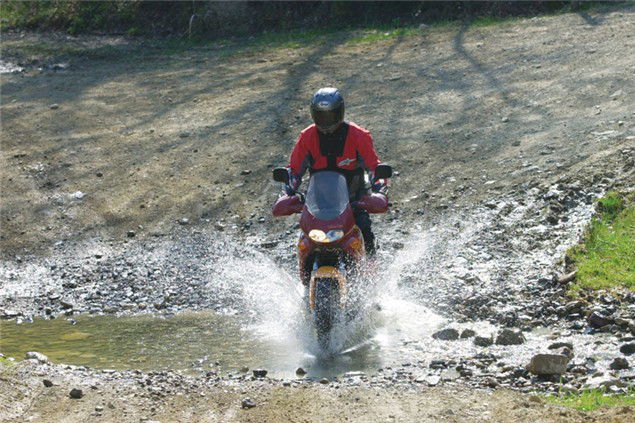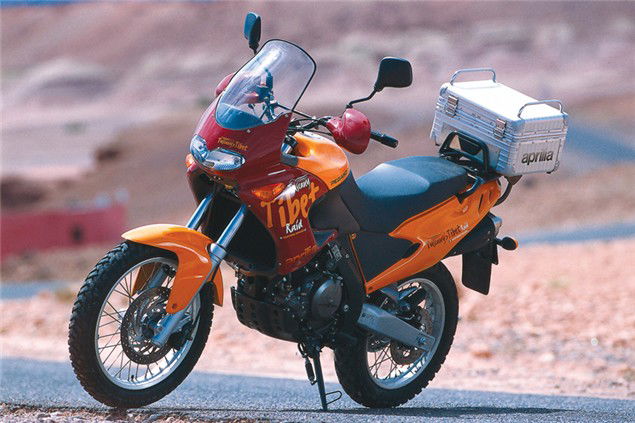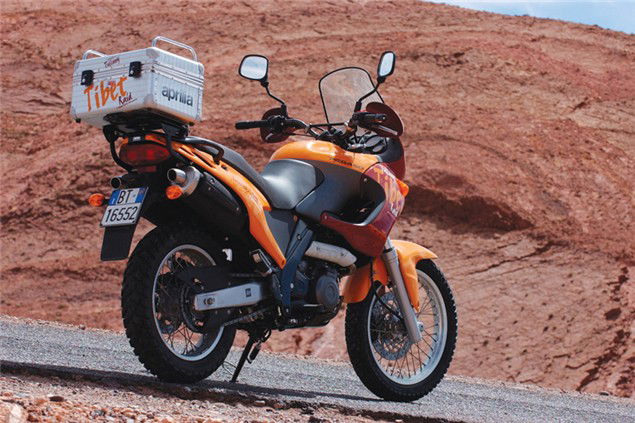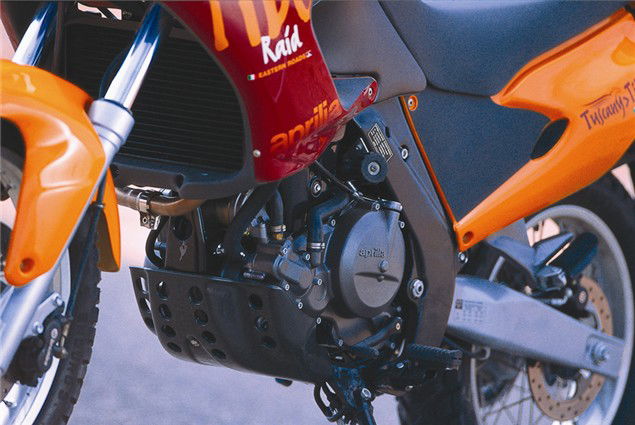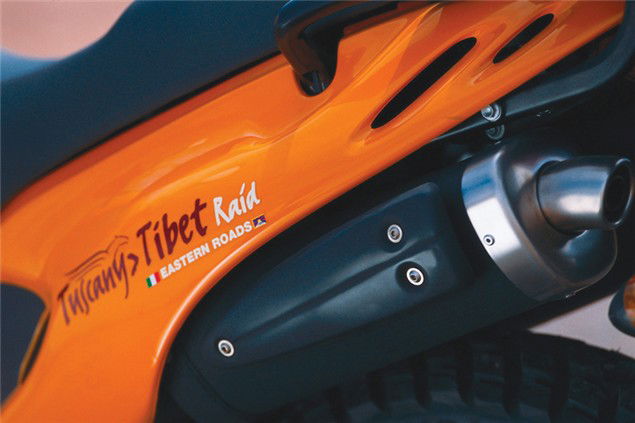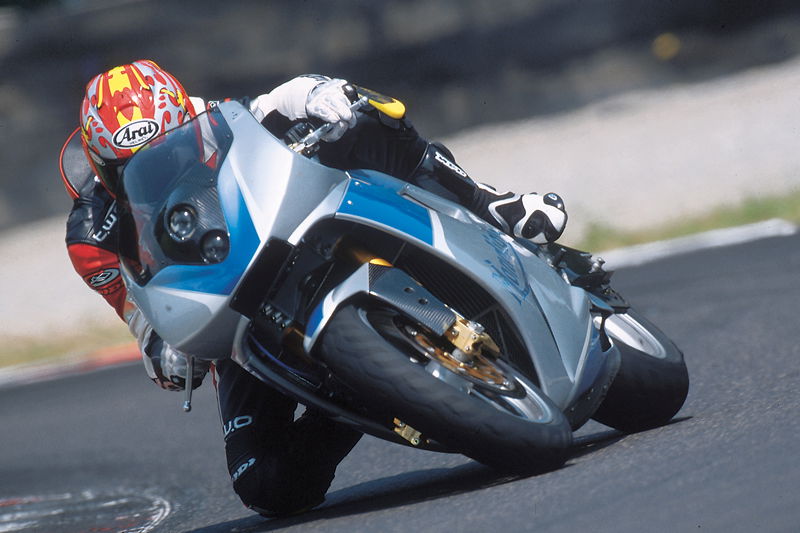First Ride: 2003 Aprilia Pegaso Tibet
Despite the Tuscany-Tibet name, Aprilia says you are allowed to do Reading-Watford and several other routes too on its new Pegaso. So we found out whether the bike's a dirt monster or one for the roads

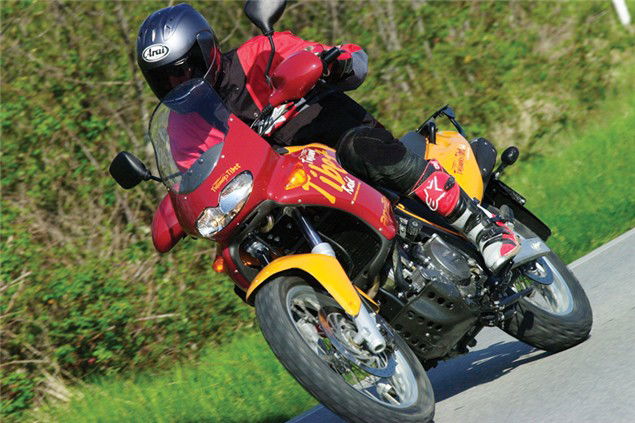
When the original Pegaso was introduced it was the most sophisticated single-cylinder production bike available. That was a full 10 years ago, and... today it's still the most
sophisticated single you can buy, thanks to its twin-choke fuel injection system and having five valves (three inlet, two exhaust) arranged radially in the cylinder head. Things don't move so fast in this class, largely because the motivation, in the form of big showroom sales, isn't there. These bikes sell quite consistently but only in relatively small numbers.
The reason for that comes down to the limitations of single-cylinder engines, which compared with their multi-pot counterparts are slow, vibratory, difficult to start and with narrow powerbands. Makes you wonder why anyone should buy one really - the light weight is cited as one reason, but the old Pegaso's 175kg dry doesn't stack up very well against a supersport 600cc four, which is around 10kg less (and with roughly 70bhp more to move it), or even an all-rounder like a Fazer, which is slightly heavier at 189kg and still vastly more powerful. Bikes like the Fazer are in the same price band too, so no advantage to the singles there either. As for simplicity, that Pegaso spec sheet not only includes full engine management, but also a pair of overhead camshafts featuring skew-cut cam lobes to operate two of the five valves at weird angles.
Aha! But...
Actually, there's no 'Aha! But..." unless you're a regular off-roader, in which case the lumpy power delivery gets you the best traction possible. There's only one valid reason for choosing a single as a road bike, and that's because you just like 'em. Whatever.
And despite its single-slug handicap, the Pegaso has always impressed. The electric foot has done away with the generic recalcitrant starting and the motor has generally felt lively and willing. In the Tuscany-Tibet (despite the name, Aprilia says you are allowed to do Reading-Watford and several other routes) that's unchanged, setting aside the inevitable damage done by a decade on the market. In fact the motor was upgraded for the Pegaso Cube in 1997, but with its roots still burrowing back to the early Nineties when genes were shared with BMW's F650 and Rotax, you do notice how other engines have moved on since.
But it's still one of the best singles around. Unlike some it will take being trickled down to 2000rpm in a higher gear without threatening to spit its transmission out the crankcase breather, and it does rev with something like gusto up to 6000rpm, and keeps on spinning if you can't be bothered to change up, although you don't go any quicker for that. The vibes are well controlled too, thanks to rubber engine mounts and a single balance shaft, and they don't interfere with your riding.
Aprilia Pegaso Model Evolution
- 1993:
The first Pegaso comes on the market, sharing design principles and production techniques with BMW's F650 (which is produced at Aprilia's Noale factory). - 1997:
Revamped Pegaso Cube replaces original model. Still fitted with twin Mikuni carbs. More rounded styling, smoother motor - 2001:
More mild restyling, but fuel injection means a name change to Pegaso 650ie
Aprilia Pegaso Review
This is all known quantity as the motor's unchanged, but the Tuscany-Tibet has several chassis alterations to justify its optimistic label. Most obvious is the new bodywork in what seems to be custard and fudge colours - there's a proper upper fairing with fair sized screen which facilitates high speed cruising without making your arms and neck ache. The seat is new and 20mm higher thanks to longer travel suspension at the front - up to 175mm - and a 25mm increase in ride height at the back to keep it on an even keel. The forks and Sachs shock are new, too. Aprilia points out that you also get an additional crossbar on the handlebars, which might not have you tumescent with excitement, and you'll have spotted the aluminium topbox yourself, which is more useful.
It doesn't seem to upset the handling either, which means you still get the reasonably flickable Pegaso - certainly, going down the same sinuous route on which I'd ridden the Caponord Rally-Raid a few hours earlier the Peg was a lot more fun and chuckable, and I suspect in the tighter stuff, quicker too. As the speed builds so the front end starts to wander slightly, and the Peg doesn't cope as well with poor surfaces as its bigger brother. But it's cheaper and lighter so you shouldn't expect it to. There is something of a budget feel to the suspension, manifested as choppiness on some surfaces and a bit of fluster if you start hustling hard. Heavy use of the front brake has the forks diving their full length before the bike begins to slow, so you need to be smooth with the Pegaso if it's going to be smooth with you.
Despite the bounciness, comfort is good, the compliant seat combining with a reasonably spacious riding position that is upright and natural, and that makes you feel in charge.
This even applies off-road, where unlike the Capo, the Pegaso is compromised by its standard rubber, dual purpose Metzeler Sahara Enduro 3s, with the emphasis on chunky road rubber. Given the dry and dusty conditions of the test there were no problems with the tyres clogging up so grip wasn't too much of a problem, and the Peg Tibet proved a useful trail bike as long as the rider's ambition was capped. Even so, the Peg feels as if it'd get to places the Caponord rider would balk at, purely because of its smaller bike manageability, so as a true trail bike it's much more believable. The only real problem is the sudden throttle response at low revs, which makes the bike awkward when you're trying to trickle it around tight obstacles. Should you tip it over though (and off road, eventually you will) there's a cut-off to stop the motor automatically.
As a touring bike the Pegaso will suit only those for whom 47bhp is enough - motorways and passengers will be hard work. There is some satisfaction to be gained from squeezing the most out of a limited output engine, especially when it's a willing one like Peg's, but there will be times when you'll want more.
As a trail bike the Tuscany fares better. The bodywork will get damaged but it's not especially vulnerable and the bike as a whole feels at home on trails and tracks.
VERDICT
If singles are your bag, then the Pegaso Wales-Liechtenstein, or whatever, is the one to go for. Unless you're a novice, then it's the gentler BMW F650CS. Mind you, it helps to be blind to own that. Except then you couldn't ride it...
Aprilia Pegaso Specs
TYPE - TRAILIE
PRODUCTION DATE - 2003
PRICE NEW - £5119
ENGINE CAPACITY - 651.8cc
POWER - 47bhp@6500rpm
TORQUE - 43lb.ft@4500rpm
WEIGHT - 183kg
SEAT HEIGHT - 835mm
FUEL CAPACITY - 21L TOP SPEED - 100mph
